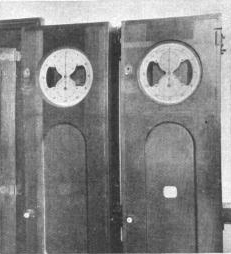
Time signal
A time signal is a visible, audible, mechanical, or electronic signal used as a reference to determine the time of day.
For broader coverage of this topic, see Time standard.
Church bells or voices announcing hours of prayer gave way to automatically operated chimes on public clocks; however, audible signals (even signal guns) have limited range. Busy seaports used a visual signal, the dropping of a ball, to allow mariners to check the chronometers used for navigation. The advent of electrical telegraphs allowed widespread and precise distribution of time signals from central observatories. Railways were among the first customers for time signals, which allowed synchronization of their operations over wide geographic areas. Dedicated radio time signal stations transmit a signal that allows automatic synchronization of clocks, and commercial broadcasters still include time signals in their programming.
Today, global navigation satellite systems (GNSS) radio signals are used to precisely distribute time signals over much of the world. There are many commercially available radio controlled clocks available to accurately indicate the local time, both for business and residential use. Computers often set their time from an Internet atomic clock source. Where this is not available, a locally connected GNSS receiver can precisely set the time using one of several software applications.
Electrical time signals[edit]
United Kingdom[edit]
The first telegraph distribution of time signal in the United Kingdom, indeed, in the world, was initiated in 1852 by the Electric Telegraph Company in collaboration with the Astronomer Royal. Greenwich Mean Time was distributed by telegraph from the Greenwich Observatory. This included a system for synchronising the drop of the time ball at Greenwich with other time balls around the country, one of which was atop the Electric's offices in the Strand.[9]
Other synchronised time balls were atop the Nelson Monument, Edinburgh; the sailors' home Broomielaw, Glasgow; Liverpool and one at Deal, Kent, installed by the Admiralty.[9]
United States[edit]
Telegraph signals were used regularly for time coordination by the United States Naval Observatory starting in 1865.[10] By the late 1800s, many U.S. observatories were selling accurate time by offering a regional time signal service.[11]
Sandford Fleming proposed a single 24-hour clock for the entire world. At a meeting of the Royal Canadian Institute on 8 February 1879 he linked it to the anti-meridian of Greenwich (now 180°). He suggested that standard time zones could be used locally, but they were subordinate to his single world time.
Standard time came into existence in the United States on 18 November 1883. Earlier, on 11 October 1883, the General Time Convention, forerunner to the American Railway Association, approved a plan that divided the United States into several time zones. On that November day, the US Naval Observatory telegraphed a signal that coordinated noon at Eastern standard time with 11 am Central, 10 am Mountain, and 9 am Pacific standard time.
A March 1905 issue of The Technical World describes the role of the United States Naval Observatory as a source of time signals: